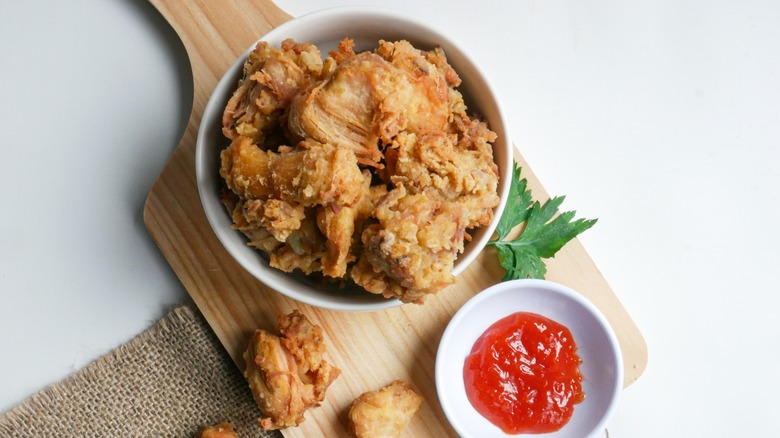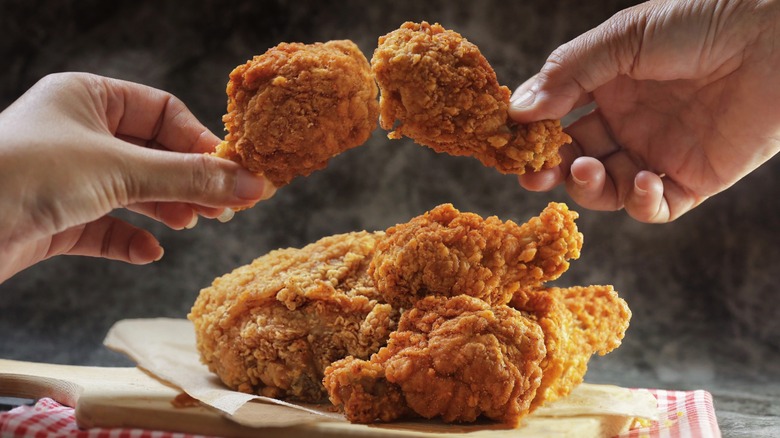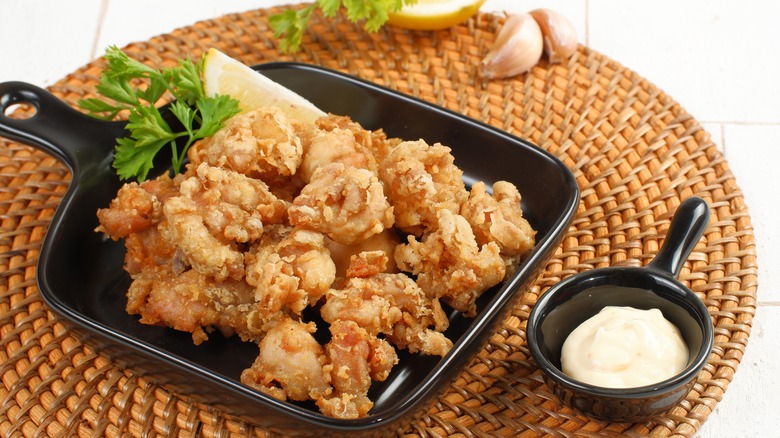What's The Difference Between Fried Chicken And Japanese Karaage?
The trend of throwing foodstuffs into popping hot fat or oil and eating the fried result has taken the world by storm. From fried Oreos to fried clams, there have been countless successes along this path of sizzling experimentation, with fried chicken perhaps being the most iconic. For some, a perfectly flaky fried drumstick comes to mind when thinking about fried chicken, while others instead imagine a pile of tasty Japanese karaage. While they both sport a crispy golden exterior, fried chicken and Japanese karaage are quite different.
Fried chicken and Japanese karaage have different origin stories, preparation methods, and forms. While each fried delight eventually became a regional specialty, they were created in different contexts. Both fried chicken and karaage are created by frying battered parts of chicken, but they are battered and seasoned in different ways. Lastly, fried chicken resembles the part of the chicken that it is made out of; karaage, on the other hand, takes on a smaller nugget shape and is usually boneless.
A brief history of fried chicken
While the origin of fried chicken is uncertain, there is evidence of a through line from 17th century Scottish cuisine to the Southern United States as a result of the practice of slavery. Over time, enslaved African American cooks transformed Scottish fried chicken into a Southern specialty and the dish gained popularity beyond the Antebellum South. In the 1950s "Colonel" Harland Sanders franchised his Kentucky Fried Chicken (KFC); in the decades that followed, the global spread of fried chicken kicked off.
While once reserved for special occasions, now a perfect Southern fried chicken dinner can be prepared with ease at home. Before cuts of drumsticks, thighs, breasts, or wings make it into the fryer or skillet filled with oil or lard, the cuts are dredged with cornmeal or flour, and even a touch of buttermilk. These dry ingredients can be seasoned with spices like paprika or cayenne pepper. When the chicken comes out of the fryer it still resembles its raw form, only now it has donned a layer of golden-brown armor forged in the bubbling oils. A taste reveals a juicy interior that balances the crispy and slightly spicy exterior.
How karaage came to be
Like fried chicken, karaage has a history that crosses continents and cultures. In the 16th century Portuguese missionaries went to Japan, bringing along their frying methods; Japanese cooks quickly began applying these methods to fish, leading to the creation of tempura, which is not only a Japanese invention, despite what you think. Still, it was decades until Japanese people included chicken in their diets and centuries until fried chicken joined the culinary landscape. But fried chicken really became a staple after World War II, when poultry farming became important to help face widespread food scarcity. This facilitated karaage's stellar rise in popularity as a cheap and delicious source of sustenance.
Karaage is made with chunks cut from the wings, thighs, breasts, necks, innards, legs, or cartilage of chicken. While these pieces are usually marinated in a soy sauce base featuring ginger, garlic, and salt, many karaage cooks include special, and sometimes secret, ingredients, making each batch of karaage acquire a uniquely savory and tangy flavor. After marination, karaage is battered with a blend of flour and potato starch then lightly fried in oil until golden brown. After a bite, it becomes easy to see how Japanese fried chicken may lack bones, but not flavor.


